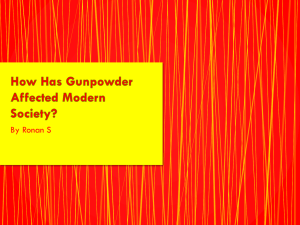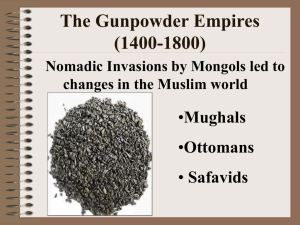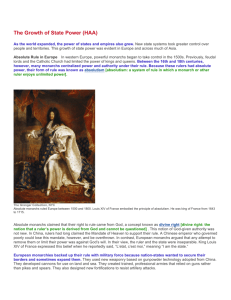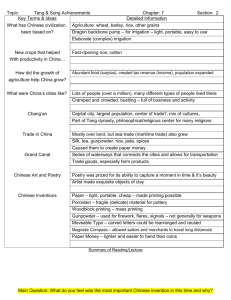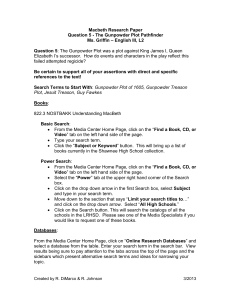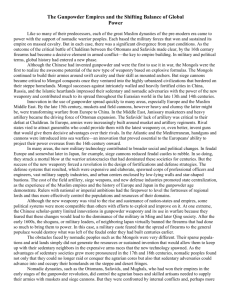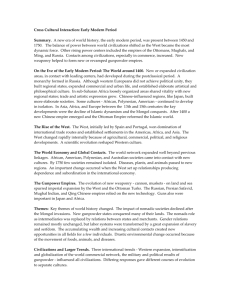Gunpowder Revolution
advertisement
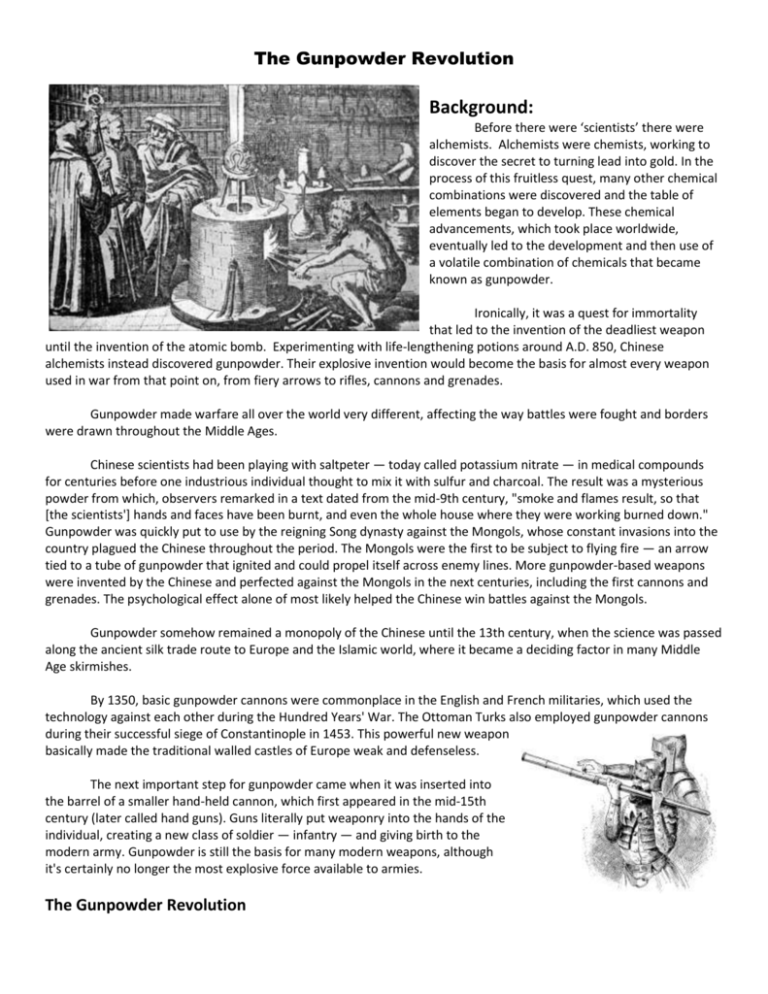
The Gunpowder Revolution Background: Before there were ‘scientists’ there were alchemists. Alchemists were chemists, working to discover the secret to turning lead into gold. In the process of this fruitless quest, many other chemical combinations were discovered and the table of elements began to develop. These chemical advancements, which took place worldwide, eventually led to the development and then use of a volatile combination of chemicals that became known as gunpowder. Ironically, it was a quest for immortality that led to the invention of the deadliest weapon until the invention of the atomic bomb. Experimenting with life-lengthening potions around A.D. 850, Chinese alchemists instead discovered gunpowder. Their explosive invention would become the basis for almost every weapon used in war from that point on, from fiery arrows to rifles, cannons and grenades. Gunpowder made warfare all over the world very different, affecting the way battles were fought and borders were drawn throughout the Middle Ages. Chinese scientists had been playing with saltpeter — today called potassium nitrate — in medical compounds for centuries before one industrious individual thought to mix it with sulfur and charcoal. The result was a mysterious powder from which, observers remarked in a text dated from the mid-9th century, "smoke and flames result, so that [the scientists'] hands and faces have been burnt, and even the whole house where they were working burned down." Gunpowder was quickly put to use by the reigning Song dynasty against the Mongols, whose constant invasions into the country plagued the Chinese throughout the period. The Mongols were the first to be subject to flying fire — an arrow tied to a tube of gunpowder that ignited and could propel itself across enemy lines. More gunpowder-based weapons were invented by the Chinese and perfected against the Mongols in the next centuries, including the first cannons and grenades. The psychological effect alone of most likely helped the Chinese win battles against the Mongols. Gunpowder somehow remained a monopoly of the Chinese until the 13th century, when the science was passed along the ancient silk trade route to Europe and the Islamic world, where it became a deciding factor in many Middle Age skirmishes. By 1350, basic gunpowder cannons were commonplace in the English and French militaries, which used the technology against each other during the Hundred Years' War. The Ottoman Turks also employed gunpowder cannons during their successful siege of Constantinople in 1453. This powerful new weapon basically made the traditional walled castles of Europe weak and defenseless. The next important step for gunpowder came when it was inserted into the barrel of a smaller hand-held cannon, which first appeared in the mid-15th century (later called hand guns). Guns literally put weaponry into the hands of the individual, creating a new class of soldier — infantry — and giving birth to the modern army. Gunpowder is still the basis for many modern weapons, although it's certainly no longer the most explosive force available to armies. The Gunpowder Revolution The introduction of gunpowder in Europe caused a revolution in warfare. New weapons, such as cannons, made heavily armored mounted knights and hand-to-hand combat obsolete. In the Medieval Ages, knights formed the private armies of independent aristocratic (upper class) landowners, but the introduction of gunpowder forced the aristocracy to become a part of the regular military of a more centralized power, taking away their independence. With the invention of the cannon they could no longer shut themselves up in a castle to avoid the wrath of their king. While gunpowder was spreading across Europe, Muslim militaries in India and central Asia (who had inherited the Mongol empire) were using gunpowder even more effectively than their European counterparts. The Gunpowder Empires is a term used to describe the Ottoman, Safavid and Mughal Empires of India and West-Central Asia. Each of these three empires had considerable military success using the newly developed firearms, especially cannon and small arms, in the construction of their empires. 1. The Ottoman Empire in Turkey The longest-lasting of the Gunpowder Empires, the Ottoman Empire in Turkey actually was first established in 1299, but it fell to the conquering armies of Timur the Lame (Tamerlane) in 1402. Thanks in large part to their acquisition of muskets, the Ottoman rulers were able to drive out the Timurids and reestablish their control of Turkey in 1414. The Ottoman Janissary corps became the best-trained infantry force in the world, and also the first gun corps to wear uniforms. Although the Ottoman Empire soon lost its technological edge, it survived until 1922, soon after the end of the First World War. 2. The Safavid Empire in Persia The Safavid dynasty took control of Persia in the power vacuum that followed the decline of Timur's empire in the 1400s. Unlike Turkey, where the Ottomans fairly quickly re-established control, Persia (today Iran) deteriorated into chaos that lasted around a century before Shah Ismail I and his "Red Head" (Qizilbash) Turks were able to reunite the country around 1511. The Safavids learned the value of firearms and artillery early, from the neighboring Ottomans. Safavid history is full of clashes and wars between the Shi'a Muslim Safavid Persians and the Sunni Ottoman Turks. Early on, the Safavids were at a disadvantage to the better-armed Ottomans, but they soon closed the arms gap. The Safavid Empire lasted until 1736. 3. The Mughal Empire in India The third gunpowder empire, India's Mughal Empire, offers perhaps the most dramatic example of modern weaponry carrying the day. Babur, who founded the empire, was able to defeat Ibrahim Lodi of the last Delhi Sultanate at the First Battle of Panipat in 1526. Babur's victorious Central Asian army used a combination of traditional horse cavalry tactics and newly designed cannons; the cannon fire spooked Lodi's war-elephants, which turned and trampled their own army in their hurry to escape the terrifying noise. The Mughal Dynasty would endure until 1857, when the incoming British exiled the last Mughal emperor. Reading Questions: 1. What were the Chinese alchemists searching for? 2. How is gunpowder made? 3. Who were the main people that the Chinese used gunpowder against? 4. The Chinese kept the secret of gunpowder for a very long time. How did this new technology spread? 5. What happened in 1453? Who were the victors? How did they win? 6. What were the three Gunpowder Empires and why were they called that? 7. How did the Ottomans use gunpowder to gain power? 8. How did the Mughals use gunpowder to gain power? 9. How did the Safavids use gunpowder to gain power? 10. How was gunpowder adapted by the different cultures? Analysis Question: Should the development of gunpowder weapons be considered revolutionary? Steps: A. Create a list of evidence from your questions above that you could use to answer the analysis question. You should have a list of at least 10 items, but more is better. B. Sort your list into categories and name your categories C. Put your categories and your analysis question together to create a thesis/claim statement D. Use your category titles and your evidence to create an outline E. Under each piece of evidence on your outline, explain HOW it proves that your claim statement is correct Turn in your claim statement and your expanded outline. Reading Questions: 1. What were the Chinese alchemists searching for? 2. How is gunpowder made? 3. Who were the main people that the Chinese used gunpowder against? 4. The Chinese kept the secret of gunpowder for a very long time. How did this new technology spread? 5. What happened in 1453? Who were the victors? How did they win? 6. What were the three Gunpowder Empires and why were they called that? 7. How did the Ottomans use gunpowder to gain power? 8. How did the Mughals use gunpowder to gain power? 9. How did the Safavids use gunpowder to gain power? 10. How was gunpowder adapted by the different cultures? Analysis Question: Should the development of gunpowder weapons be considered revolutionary? Steps: A. Create a list of evidence from your questions above that you could use to answer the analysis question. You should have a list of at least 10 items, but more is better. B. Sort your list into categories and name your categories C. Put your categories and your analysis question together to create a thesis/claim statement D. Use your category titles and your evidence to create an outline E. Under each piece of evidence on your outline, explain HOW it proves that your claim statement is correct Turn in your claim statement and your expanded outline. https://www.youtube.com/watch?v=FIzR9nfO6Rk
